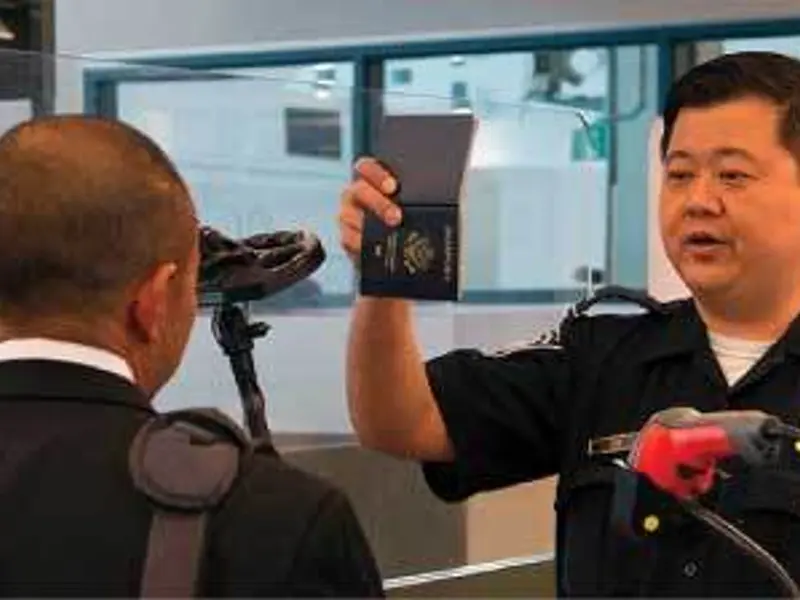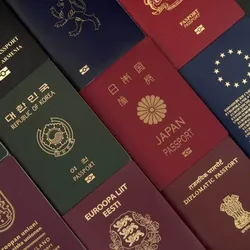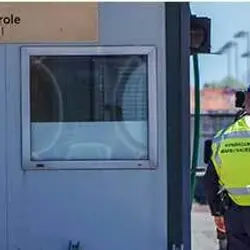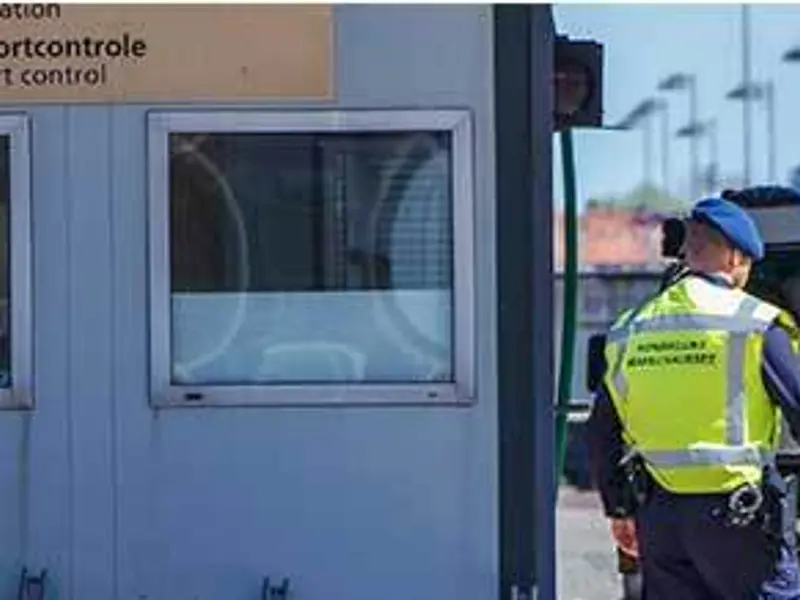Border Security
AI and name matching technology improve border security and watchlist screening to facilitate legitimate traffic while reducing risk.

What is border security?
The United States Department of Homeland Security defines border security as the act of “protecting … borders from the illegal movement of weapons, drugs, contraband, and people, while promoting lawful trade and travel.”[1] The United Kingdom Border Force describes it as any action that “secures the border and promotes national prosperity by facilitating the legitimate movement of individuals and goods, whilst preventing those that would cause harm from entering the UK.”[2] In South Africa, “border security is a comprehensive process that involves all functions to regulate and manage the movement of people and goods across borders.”[3] In India, border management agencies seek “border region development, communication, and coordination with neighbouring states and programs to enhance the national interests of India.”[4]
Although their wording differs, the intent of these definitions is consistent. Around the world, countries now look at their borders as national front doors. Nations want to provide easy passage to the overwhelming majority of would-be visitors who seek entry for legitimate purposes. This easy flow of people and goods is vital to national economies that increasingly depend on tourism and international commerce.
However, national governments nonetheless spend countless time and money protecting their borders from the minuscule percentage of people and businesses that seek to cause harm. These are the risks posed by terrorists, human traffickers, drug runners, arms dealers, and purveyors of counterfeit goods — all of whom seek international passage alongside families visiting the Grand Canyon, Big Ben, elephant preserves and the Taj Mahal.
Improving border security through integrated management
Increasingly, border security agencies look toward integrated border management (IBM) as a way to concurrently facilitate legitimate passage and improve national security.
In many countries, a broad array of agencies operating from federal to local levels of government assume some responsibility for securing land crossings, airports, and maritime borders. IBM is an emerging approach to integrating border-related systems, processes, people, and data. It requires significant collaboration among these often-siloed agencies. This collaboration most often takes place among different agencies working at different levels of one country’s government. However, it can also occur among neighboring countries.
New technologies to better match names and glean insight from open-source intelligence (OSINT) aid IBM efforts — empowering border officials from disparate agencies to share information so they can more efficiently screen people and businesses.
Data sharing is the first step toward integrated border management.


Who’s in charge here?
Nations often divide responsibility for border security among a plethora of different agencies. Take the United States, as an example. Even after integration efforts forged in the wake of the 9/11 terrorist attacks, border security agencies still include:
Federal agencies — U.S. Customs and Border Protection secures and facilitates operations at 328 ports of entry across the county, processing nearly 300 million visitors each year.[5] The Department of State issues visas, including nearly 7 million non-immigrant visas annually.[6] They are joined in their efforts by the Department of Defense; by the Department of Justice/Federal Bureau of Investigation; and by Department of Homeland Security agencies including Immigration and Customs Enforcement, the United States Border Patrol, the Federal Emergency Management Agency, and the Transportation Security Administration.
State agencies — State agencies involved with border security and customs enforcement include state police departments, the National Guard, and state departments of public policy.
Local and regional agencies — These include county sheriff’s offices, municipal police departments, and regional port and airport authorities.
The United States is not alone in its approach to customs and border security. In the United Kingdom, at least 27 different agencies have some role to play in border management.[7] These include security, policy, health, immigration, and customs agencies.
Learn more about border security

Case Study
USCBP: Strengthening U.S. Borders with Intelligent Name Matching

Blog
Address These Five Name Matching Issues to Improve Border Security
Customs and border security have never been more important. Around the world, professionals from a broad variety of federal, state, and local governments strive...

Video
AI-driven Solutions to Enhance Border Security

Data Sheet
Artificial Intelligence Solutions for Enhanced Border Security
How the AI-powered name matching capabilities of Babel Street Analytics help border security agencies screen entities and reduce cross-border crime.
Legacy technology hinders border security
Technology now used at many border security organizations inhibits the development of IBM processes. In worst-case scenarios, technological limitations may even keep border officials from effectively performing everyday tasks.
How?
Consider name matching. In border security and other high-stakes name matching situations, a false negative can have devastating consequences — leading to terrorists or other criminals entering a country. On the other hand, too many false positives result in slower-than necessary border operations — stalling legitimate trade and tourism.
To make these determinations at speed and at scale in a world where international criminals and criminal networks have become more sophisticated, border security agents need cutting-edge name matching and OSINT capabilities.
Let’s take a look at some of the shortcomings of existing technologies, and how modern name matching and OSINT platforms can help overcome them.

Inadequate name matching capabilities
Too many customs and border security agents rely on outdated search platforms to match names in structured text, such as when watchlist screening. Returning only exact or near-exact matches, search platforms are fuzzy enough for general searches, but not expansive or fast enough for optimized name matching. Many accommodate only a limited number of languages, making it difficult to match for translated names, transliterated names, and names rendered in non-Latin scripts. They fail to spot aliases, nicknames, misspellings, honorifics, or disordered names. Binary processes also fail to accommodate the various naming conventions used in different parts of the world: not every country follows First Name/Middle Name/Last Name models.
Due to these inadequacies, border officials miss too many matches, allowing entry of criminals and contraband. Conversely, by returning too many false positives, these systems lead to unnecessary security alerts. Border officials must spend time investigating these unnecessary alerts, slowing the movement of legitimate travelers and goods.
AI-powered fuzzy name matching can help border security professionals overcome the challenges of matching names in structured text. Automated AI-powered algorithms use a variety of criteria to quickly, accurately, and intelligently match and disambiguate names of people, organizations, and locations across a broad array of languages, scripts, and databases.
Suboptimal entity resolution
"Entity resolution" is the process of distinguishing between similarly named entities appearing in unstructured text, then matching those names to entities appearing in a public knowledge base or the knowledge bases maintained by your organization.
Why is this capability important? Without entity resolution capabilities, State Department officials issuing B-1 business visas will struggle to distinguish between “Peter Smythe,” a history teacher in the United Kingdom hoping to take a camping vacation in the Western United States, and the “Peter Smythe” drug runner with significant cartel ties.
Entity resolution capabilities offered by modern name matching platforms automatically append identifying data to each name in order to distinguish between one Peter Smythe and another. These identifiers include age, gender, street addresses, email addresses, and telephone numbers. Identifiers can also include information on the traveler’s family members, employment, and education.
Similar capabilities distinguish between corporate identities. Many companies have similar names. In addition, the corporate world commonly uses initialisms and nicknames “PennyLuck Pharmaceuticals” may often be referred to as “PennyLuck Drugs.” You may regularly dine at your favorite chain restaurant, “Bobby D’s.” The right name matching and entity resolution solutions can link this initialism to the company’s official name, “Robert D’Amico Foods, Inc.”


Limited insight from open-source intelligence
OSINT is any insight gleaned from publicly available information (PAI) or commercially available information (CAI). This data includes social media posts, news stories and videos, information appearing on web sites, and more. Border security officials can use modern OSINT platforms to detect and track illegal cross-border activity; monitor the movements of individuals and groups of interest; and obtain real-time threat intelligence and response planning.
While OSINT platforms are now used by certain border security agencies, these systems are too often outdated, suffering from:
- Poor data quality — The PAI searched can be incomplete or outdated.
- Inaccurate data — Improperly curated PAI can contain errors, biases, and inconsistencies that negatively affect the validity of insights derived from it.
- Insufficient data sources — Too many PAI systems collect data from a limited number of sources, leading to limited insight.
- An inability to accommodate data volume — PAI data is generated in huge volumes — too much for some PAI systems to appropriately search, process, and analyze.
Without cutting-edge technology to search, monitor, and analyze PAI in real time, border security officials are left without the insight needed to both ease passage for legitimate travelers and ban questionable people from entering their countries. Concurrently, modern OSINT platforms help border officials better address both potential and present threats.
Siloed legacy systems
Efforts to integrate border management are further hampered by legacy systems’ inability to communicate with each other. One outdated system simply cannot work well with another to find and present the data needed to pre-screen travelers and businesses, then communicate findings among agencies. Replacing these systems, or retooling them to communicate better, can be prohibitively expensive.
The solution? Modern name matching and OSINT platforms that work via application programming interfaces (APIs). Each API sits atop an agency’s existing systems. This helps organizations avoid the need to replace expensive systems to improve name matching and OSINT.


Lack of speed
When checking names and searching PAI, either from offices (as part of visa application processes) or at the border itself, many border security officials find investigative processes take too long. Old technology slows tourism and commerce. Worse, border agents charged with point of entry screening have only minutes to investigate each traveler. Slow, outdated technology adds pressure to an already challenging situation.
Powered by AI, modern name matching and OSINT platforms speed investigative processes. Tasks that might take a human investigator hours or even days to complete — such as detecting activities or information that might signal potential terrorism, drug trafficking, or other illegal activities — AI can do in minutes.
Why Babel Street?
Babel Street Modules and Insights products help border security agencies meet their needs for better, faster name matching, entity resolution, and OSINT insight. These capabilities bolster existing border security efforts and prepare agencies for integrated border management.
AI-powered Babel Street Match matches names across 130 languages and more than a dozen scripts, detecting aliases, nicknames, misspellings, and out-of-order names. To coalesce identities (to find the right “Peter Smythe” in a sea of “Peter Smythes”) the platform applies additional identifiers to each name examined. Similar capabilities help link corporate names to their nicknames and initialisms, and to names of their subsidiaries. In doing so, Match both improves matching capabilities and dramatically reduces instances of false positives — saving investigative time. Clear confidence scores help users understand why the platform has deemed two names a “match” or a “mismatch.” Match also empowers you to adjust match parameters according to your use case.
Babel Street Insights trawls for information across all layers of the internet. Information examined comes from a broad array of web sites (including those hosted on the deep and dark web), social media sites, and real-word interactions generated on chats, in online comments, and in social media posts. Insights also searches its own large and diverse libraries of enriched data from commercially available sources. Conducting these searches and coalescing data, Insights complements Text Analytics entity resolution capabilities — matching names found in unstructured text to entities appearing in a public knowledge base or the knowledge bases maintained by your organization.
All the insight in the world does border officials no good if it’s presented in a language they can’t understand. This is obviously true for news articles, social media posts, and other pieces of PAI. It is also true for names. It’s a safe bet that very few American border officials would recognize the name “Владимир Путин” as “Vladimir Putin.” That’s why Match and Insights automatically transliterate names and translate content from an array of different languages, helping border security officials to match names and monitor online content from around the globe.
As discussed earlier, interoperability with legacy systems is a significant issue for those who want to deploy modern border solutions. Our API-based solutions make deployment easier. They work on top of legacy systems to facilitate sharing from one application or data silo to another — helping users avoid the need to replace or re-tool older systems.
In using Match, Text Analytics, and Insights, border security agencies are often able to:
- Streamline border processing
- Dramatically reduce instances of false positive name matches while concurrently missing fewer matches
- Screen for threats with greater context and understanding
- More quickly respond to and mitigate threats
- Improve analysis and collaboration capabilities, forging a path toward integrated border management
- Close the widening chasm between the escalating volume and variety of data that must be examined to secure borders, and the resources organizations have available to monitor that data.
Babel Street’s AI-powered software empowers border security officials with the name matching and OSINT capabilities needed to uncover critical insights across the massive digital landscape. That’s why a large majority of United States national security agencies along with similar agencies worldwide have partnered with us. And why our software is used for more than half a billion watchlist checks each day.
You might also like

Data Sheet
Artificial Intelligence Solutions for Enhanced Border Security
How the AI-powered name matching capabilities of Babel Street Analytics help border security agencies screen entities and reduce cross-border crime.

Blog
Enhancing Integrated Border Management with AI and Public Information
What’s a national border for? Why do so many countries invest in integrated border management (IBM)?If you say, “To keep out the bad guys,” you’re only half rig...

Blog
Name Matching Fails: The Real-world Consequences
Who needs name matching?There are nearly 8 billion people on this planet. Some of us are going to have the same name.This situation challenges financial institu...

Blog
Name Matching Fails: The Lighter Side
Name matching is vitally important. At Babel Street, we get that. We understand that financial institutions, law enforcement agencies, national security organiz...
Border security FAQs
Endnotes
1. U.S. Department of Homeland Security, “Border Security,” accessed February 2024, https://www.dhs.gov/publications-library/border-security#:~:text=Protecting%20our%20borders%20from%20the,economic%20prosperity%2C%20and%20national%20sovereignty
2. Gov.UK, “Border Force: About Us,” accessed February 2024, https://www.gov.uk/government/organisations/border-force/about#:~:text=Border%20Force%20secures%20the%20border,staff%20at%20ports%20and%20airports
3. Border Management Authority (South Africa), “About Us,” accessed February 2024, https://www.bma.gov.za/about-us/
4. The Centre for Security Studies, “India’s Border Management,” accessed February 2024, https://jgu.s3.ap-south-1.amazonaws.com/jsia/India's+Border+Management.pdf
5.U.S. Customs and Border Protection, “Traveler and Conveyance Statistics,” accessed February 2024, https://www.cbp.gov/newsroom/stats/travel
6.U.S. Department of State, “Report of the Visa Office 2022,” accessed February 2024,https://travel.state.gov/content/travel/en/legal/visa-law0/visa-statistics/annual-reports/report-of-the-visa-office-2022.html
7. Smith, Tony, “Bridging Borders: How AI and Public Information Sources Enhance Integrated Border Management,” Babel Street webinar, accessed February 2024, https://www.babelstreet.com/landing/bridging-borders-how-ai-and-public-information-sources-enhance-integrated-border-management
Disclaimer
All names, companies, and incidents portrayed in this document are fictitious. No identification with actual persons (living or deceased), places, companies, and products are intended or should be inferred.


